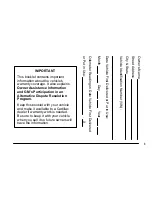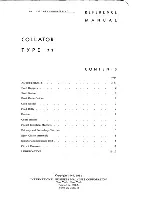
LR-3510
Stock No. 1656589
Page 5 of 9
4.
Place a rear hinge on each end of the rear hinge shaft installed in Step #3. Secure one end with a 2 1/8"
O.D. x 1 3/8" I.D. washer and a 1/4" x 2" cotter pin. On the opposite end of the shaft, slide the weld-in-
block supplied against the rear hinge. Weld the block in place. Cut off the excess rear hinge shaft.
NOTE:
If an obstruction can not be cleared by moving the hoist forward or rearward, the hoist may be
reverse mounted as shown in Fig. #1, or the portion of the hoist that extends below the frame
may
be lifted to the frame level without affecting the capacity or performance of the hoist. Be aware
that lifting this portion of the hoist will raise the hoist mounting height.
NOTE:
The distance between the rear hinge shaft center and the saddle center is referred to as the "M"
dimension. In Fig. #1, the "M" dimension for several dump angles are tabulated.
NOTE
:
Moving the hoist rearward or forward along the truck frame will affect the hoist's performance.
A forward movement will reduce the dump angle and will increase capacity while a rearward
movement will increase the dump angle and reduce capacity.
SECTION C -- INSTALLATION OF HOIST FRAME:
1.
Slide a lock collar onto each saddle shaft. Slide each saddle shaft into the lower tube as shown in
Fig. #4.
2.
Locate the hoist on the truck frame, making sure to center the hoist right and left, and to square the
hoist with the truck frame. The LR-3510 is designed to rest on the truck frame as shown in Fig. #1.
A small portion of the hoist extends below the truck frame level. The hoist therefore, may have to
be moved forward or rearward to avoid obstructions below the frame level.
3.
When the hoist is positioned, place a mounting angle under each side of the hoist saddle. Secure
each mounting angle to the truck frame by drilling two 17/32" dia. holes and installing two 1/2" x 1
1/2" hex cap screws, two 1/2" lock washers and two 1/2" hex nuts (Fig. #4).
4.
Weld each end of the hoist saddle bracket to the corresponding mounting angle (Fig. #4).
NOTE:
Do not
weld the hoist or mounting angle to the truck frame.
NOTE
:
The hoist saddle must set directly on the truck frame. If rivet interference is encountered,
counter sink the rivet head into the hoist saddle.
SECTION D -- INSTALLATION OF PUMP BRACKET:
1.
Position and clamp the pump bracket to the chassis frame in a convenient location. Make sure the
location of the pump is close enough to allow the hose to connect the pump to the hoist cylinder.



























